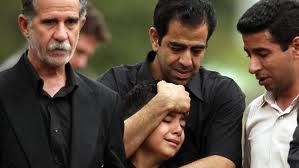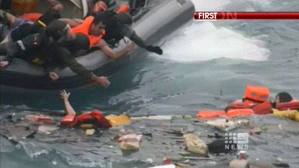by Nasya Bahfen
It was not nearly as dramatic as the footage beamed around the world of thousands of jubilant Egyptians celebrating in Tahrir Square, but the image of nine year old Seena Akhlaqi Sheikhdost caused a quiet revolution in Australia this week. Last December, the flimsy boat carrying Seena and up to a hundred Iranian, Kurdish and Iraqi asylum seekers smashed into a rocky cliff on the remote Australian territory of Christmas Island in the Indian ocean. Seena survived the shipwreck. His parents and brother did not. In early February, the first of the victims were buried in Sydney, including Seena’s father (the bodies of his mother and brother have not been found). Over and over again, Australians saw on television and in the newspapers gut-wrenching images of Seena’s face crumpled up in tears watching his father laid to rest in a traditional Muslim funeral, as members of his Sydney-based extended family tried in vain to console him.
The issue of asylum seekers who arrive by boat is a fiercely divisive one. It is played out in the media through a paradigm of xenophobia (those seeking refugee status have largely been Middle Eastern, at a time when the nature and legitimacy of Islam’s presence in Australia is being questioned); exaggeration about the size of the problem compared to, say, illegal immigrants who arrive by plane and overstay their visas; and false claims about the supposed entitlements of the overwhelming majority of boat arrivals who are ultimately found to be genuine refugees.
Under former Prime Minister John Howard, who was elected to power on border patrol issues, asylum seekers who tried getting to Australia by boat – including children – were incarcerated under a controversial “mandatory detention” policy. In 2001, the Howard government built a temporary immigration detention centre on Christmas Island, intending to replace it with a permanent facility elsewhere. The current Australian Labor Party, when it defeated Howard’s (conservative) Liberal-National Coalition in 2007, and fearing it would lose popularity, continued to detain asylum seekers and process their claims for refugee status “off shore.”
Former Labor prime minister Bob Hawke has asserted that Australia is a nation of boat people, but despite attempts by refugee advocates to change the narrative on asylum seekers through using facts and statistics, ignorance and hatred of the “queue jumpers” remains, stoked by the media and politicians. One of those politicians, from the Coalition (now in Opposition), invoked outrage when he suggested that taxpayer funds should not have been used to fly the surviving relatives of the Christmas Island shipwreck from the island where they had been detained, to Sydney where their family members were being buried.
Coalition immigration spokesman Scott Morrison said the shipwreck victims should instead have been buried on Christmas Island (the site of the shipwreck and the detention centre, and an extraordinarily remote and expensive place to get to). He later conceded that the timing of his comments was insensitive, prompting Australian comedian Chas Licciardello to tweet that he agreed that the timing was inappropriate because the remarks “would have been better made in the 12th century.”
Morrison’s gaffe last week was soon superseded in the Australian media by news that after twenty fours outside of detention to attend the funerals and see their extended families in Sydney, the group of shipwreck survivors (including nine year old Seena and two other children orphaned by the accident) would be flown back to the detention centre on the island that was the scene of their devastating trauma. That move was incomprehensible to many Australians, and to mental health experts such as former Australian of the Year and psychiatrist, Professor Patrick McGorry, and the government’s consultant psychiatrist, Professor Louise Newman. Seena became the focal point of outrage over the decision by Australian immigration minister Chris Brown, who quickly backed down from sending the survivors back to the island, and told a commercial television network that the boy would be released into the care of his extended family in Sydney as soon as possible.
The media’s swift switch in focus was stark, from demonizing asylum seekers as “unAustralian” because of their faith (predominantly Muslim) or ethnic origin, to concern for their welfare. The Courier-Mail (a newspaper run by News Corp’s Australian subsidiary News Limited, whose publications tend to take a conservative stand on asylum seekers and immigration) said it was a week that did not show the best of Australia, and urged those in power to think about people and not politics. The national editor of the Sydney Morning Herald urged politicians to “heed the lessons from the weak” (clearly the pun was fully intended), while commercial television reporters could not help beaming as they announced the reactions of Seena’s extended family to his pending release. In a few short days, media images of an Iranian child who had lost everything and was subsequently subject to unconscionable bureaucratic cruelty had succeeded where years of activism by refugee advocates had failed: by putting a face – a young and grieving face – to an issue the Australian media had dehumanized for too long.
Nasya Bahfen is a journalism lecturer at RMIT University in Melbourne and a journalist with Radio Australia. In 2010-2011 she is a visiting scholar with NYU’s Center for Religion and Media.



